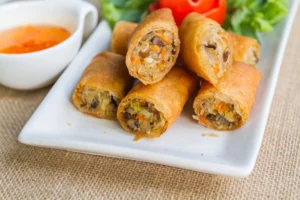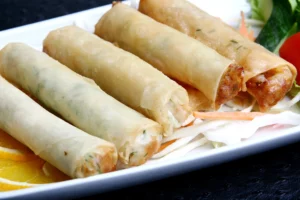
Ah, spring rolls – those delightful little parcels of joy that dance on the taste buds and whisk us away on a culinary adventure. Whether they’re served fresh or fried, these rolls have nestled comfortably into the hearts (and stomachs) of food lovers across the globe. But here’s the million-dollar question: Are spring rolls a healthy choice, or are they a guilty pleasure best enjoyed in moderation? Let’s dive in and unwrap the mystery.
Originating from Asia, spring rolls have a rich history that spans several countries, each adding its unique twist to this versatile dish. From the crisp, golden versions enjoyed in Vietnam to the fresh, herb-filled delights found in Thailand, spring rolls are as diverse as the cultures they come from. They’ve become a staple in various cuisines, not just for their irresistible taste but also for the way they bring people together – a true testament to their universal appeal.
Stay tuned as we roll into the next section, where we’ll dissect the nutritional overview of spring rolls, shedding light on what makes them tick and how they can either be a boon or a bane to your health. It’s a journey through the world of flavors and nutrition, and you’re invited to come along for the ride.
What Makes Up a Spring Roll?
Diving into the heart of spring rolls, it’s like opening a treasure chest of flavors and textures. But what exactly is tucked inside these delightful parcels? And more importantly, how do their ingredients impact their standing on the health meter? Let’s unwrap the mystery and take a closer look at the nutritional content that defines these rolls.
Ingredients Analysis
At their core, spring rolls are a celebration of simplicity and freshness. The fresh variety, often seen in Vietnamese cuisine, is a colorful mosaic of vegetables, lean meats, or shrimp, all snugly wrapped in rice paper. These ingredients aren’t just a feast for the eyes; they’re also packed with nutrients. Vegetables like carrots, cucumbers, and lettuce add a crunch, along with a healthy dose of vitamins and fiber. When shrimp or lean meats join the party, they bring protein to the table, making spring rolls a well-rounded snack or appetizer.
On the flip side, the fried version, while equally tantalizing, takes a different nutritional path. The same basic ingredients are there, but they’re enveloped in a wheat-based wrapper that’s deep-fried to golden perfection. While this method adds an irresistible crunch, it also introduces additional fat and calories into the equation. It’s a classic case of how cooking methods can sway the healthfulness of a dish.
Nutritional Content
When it comes to the numbers, spring rolls can be a bit of a chameleon, changing their nutritional profile based on their ingredients and preparation method. Fresh spring rolls are generally lighter, with a single roll containing roughly 60 to 100 calories, depending on the fillings. They’re low in fat, high in fiber, and provide a modest protein boost, especially when filled with shrimp or chicken.
Fried spring rolls, however, tell a different story. A single roll can pack anywhere from 100 to 200 calories, with the majority coming from fats. Though they might offer a protein punch, the trade-off in terms of fat and calorie content is something to consider for those watching their intake.
Yet, it’s not all black and white. The beauty of spring rolls lies in their versatility. By choosing the right fillings and cooking methods, you can tip the scales towards health without sacrificing flavor. It’s about making informed choices that align with your nutritional goals, whether that means sticking to fresh rolls for a light bite or indulging in the fried version for a treat.
As we roll into the next section, we’ll explore the health benefits and potential concerns associated with spring rolls. It’s a journey through the nuances of nutrition, offering insights on how to enjoy these delightful rolls in the healthiest way possible. Stay tuned, because the world of spring rolls is as deep and varied as the flavors they encapsulate.
Health Benefits of Spring Rolls

Navigating the world of spring rolls, it’s clear they’re not just a treat for the palate but can also be a boon for your health, especially when chosen wisely. Let’s delve into the health benefits these rolls can offer, particularly when they’re in their freshest form.
Fresh Spring Rolls
The fresh variety of spring rolls is a vibrant bundle of nutrition. Packed with raw vegetables, these rolls are a powerhouse of vitamins, minerals, and dietary fiber, essential for maintaining a healthy digestive system. The inclusion of ingredients like carrots, bell peppers, and lettuce means you’re getting a dose of antioxidants, which are crucial for fighting off free radicals and reducing inflammation.
Moreover, when these rolls are filled with lean proteins such as shrimp or grilled chicken, they become a balanced meal that supports muscle growth and repair. The protein content not only makes them more satisfying but also helps in stabilizing blood sugar levels, making them an excellent choice for a nutritious snack or part of a balanced meal.
Dietary Fiber Content
One of the standout benefits of indulging in fresh spring rolls is their dietary fiber content, thanks to the abundance of vegetables wrapped inside. Dietary fiber is a key player in maintaining bowel health and can help prevent constipation. It also plays a role in controlling blood sugar levels and has been linked to a lower risk of heart disease. By incorporating fresh spring rolls into your diet, you’re not just treating yourself to a delicious snack; you’re also contributing to your daily fiber intake, promoting overall health and well-being.
The health benefits of spring rolls, particularly the fresh variety, are hard to overlook. They embody the principle that what’s good for the body should also be a delight for the senses. However, it’s important to remember that not all spring rolls are created equal. The next section will shed light on potential health concerns associated with spring rolls, particularly those of the fried persuasion, and how they stack up against their fresher counterparts. Stay tuned as we continue to unravel the layers of this culinary delight, ensuring you can make the healthiest choices without compromising on taste.
Potential Health Concerns
While spring rolls can be a nutritious addition to your diet, especially the fresh variety, it’s crucial to navigate the waters carefully when indulging in their fried counterparts. Let’s peel back the layer of crunch to uncover the potential health concerns tied to enjoying these crispy treats.
Fried Spring Rolls
The allure of fried spring rolls lies in their golden, crispy exterior, a texture achieved through deep frying. This cooking method, while delicious, introduces a significant amount of fats, particularly saturated and trans fats, depending on the oil used. These fats increase the risk of heart disease and cholesterol levels. For those mindful of their heart health or watching their calorie intake, this could be a red flag.
Moreover, the frying process can diminish the nutritional value of the fillings. Vitamins and antioxidants found in vegetables can degrade when exposed to high temperatures, reducing the overall health benefits of the ingredients inside. It’s a trade-off between taste and nutrition that deserves consideration.
Sodium Content
Another aspect to watch is the sodium content in spring rolls, particularly those that are pre-made or served in restaurants. Sodium can sneak its way into the fillings and the dipping sauces, contributing to an increased risk of high blood pressure and heart disease over time. For individuals with dietary restrictions related to sodium, this could be a concern worth noting.
While fried spring rolls offer a tempting taste experience, their impact on health can’t be ignored. It’s about finding a balance and making informed choices that align with your dietary goals and restrictions. Opting for fresh spring rolls or moderating your intake of the fried variety can be a step towards enjoying these delights in a way that’s kinder to your body.
As we continue to explore the world of spring rolls, the next section will guide you on making healthier choices. Whether you’re a die-hard fan of the crispy version or prefer your rolls fresh and light, there are ways to enjoy this beloved dish without compromising on health. Stay tuned for tips on choosing healthier fillings, alternative cooking methods, and how to incorporate spring rolls into a balanced diet.
How to Enjoy Spring Rolls Healthily
Embracing the world of spring rolls doesn’t mean you have to compromise on health. Whether your heart is set on the crispy delight of fried rolls or the fresh zest of the non-fried variety, there are ways to keep your indulgence on the healthier side.
Choosing Healthier Fillings
The journey to a healthier spring roll starts with the filling. Opt for a rainbow of vegetables to maximize the nutrient profile—think bell peppers, carrots, cucumbers, and leafy greens. These not only add color and crunch but also pack a punch of vitamins, minerals, and fiber. Opt for lean protein choices like grilled chicken, tofu, or shrimp to increase protein without extra calories or fat.
Cooking Methods
If the allure of crispy spring rolls is too hard to resist, consider alternative cooking methods that reduce the fat content. Baking or air-frying can achieve that coveted crunch without the need for deep frying. These methods significantly cut down on the oil used, making your spring rolls a lighter option. Remember, it’s not just what you eat but how it’s prepared that counts.
Portion Control
Moderation is key when enjoying spring rolls, especially the fried variety. Savoring them as an occasional treat rather than a daily indulgence can help maintain a balanced diet. Pair them with a side of fresh vegetables or a light soup to round out your meal, ensuring you get a mix of textures and nutrients without overdoing it on portions.
Linking Out to Resources
For those keen on diving deeper into making balanced dietary choices, the ChooseMyPlate.gov website offers a wealth of information on guidelines for a balanced diet. It’s a fantastic resource for understanding how to incorporate a variety of foods into your meals in a way that supports your health goals.
Embracing healthier versions of spring rolls doesn’t mean sacrificing flavor or enjoyment. Enjoy spring rolls with nutritious fillings, lighter cooking, and portion control for a tasty, healthy lifestyle. As we conclude, remember small tweaks to dishes can enhance your dietary pattern, balancing flavor and nutrition effectively. Stay tuned for answers to common questions about spring rolls, clearing up any confusion or concerns.
Frequently Asked Questions
Are Spring Rolls Gluten-Free?
This is a hot topic for those managing gluten sensitivities or celiac disease. Fresh spring rolls wrapped in rice paper are naturally gluten-free, making them a safe choice. Exercise caution with fried spring rolls due to potential gluten in wrappers and fillings. Always check the ingredients or, when dining out, inquire about gluten-free options to ensure your meal aligns with your dietary needs.
Can Spring Rolls Fit into a Keto Diet?
For those navigating a keto lifestyle, the carb content is key. Fresh spring rolls, with rice paper and vegetable fillings, may not align with strict keto diets due to higher carb content. However, modifying the fillings to include more protein and less starchy vegetables can make them more keto-friendly. As always, moderation and mindful ingredient selection are your best allies.
How Can I Make Vegan Spring Rolls?
Veganizing spring rolls is a breeze and a delightful exploration of plant-based fillings. Choose tofu or tempeh for protein, and fill rolls with vegetables like avocado, bell pepper, and lettuce. For the dipping sauce, ensure it’s free from fish sauce or shrimp paste, common ingredients in traditional recipes. The versatility of spring rolls makes them a perfect canvas for vegan creativity.
Conclusion
Spring rolls shine as a versatile, beloved dish in global cuisine, weaving flavors and textures into delightful experiences. Spring rolls cater to every palate, from fresh, vibrant rolls with crisp vegetables to indulgent, crispy fried versions. Yet, as we’ve explored, their healthfulness can vary greatly depending on the choices made in their preparation and consumption.
Embrace spring rolls mindfully with fresh ingredients, healthier cooking, and portion control in a balanced diet. Spring rolls adapt to various dietary needs—gluten-free, keto, vegan—without compromising flavor, supporting health-conscious choices.
In conclusion, let’s remember food as both nourishment and a source of joy and exploration. Enjoy diverse flavors like spring rolls while prioritizing health and well-being through informed choices. Roll up your sleeves and let spring rolls bring color and taste to your healthy eating adventures.
